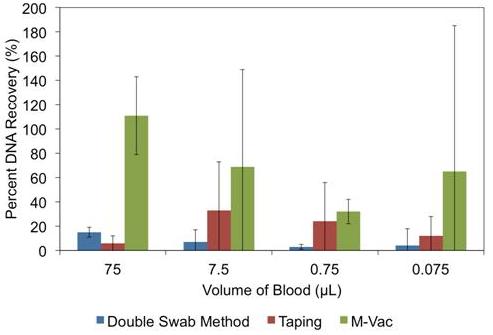
Boston - Swabbing and Tape - Denim
Objective: In this phase of the study, traditional biological collection methods, including the double swab method and tape, are compared to a wet vacuum system, the M-Vac™, through the collection of different volumes of blood (0.075 to 75 microliters) on denim.
Methods: Each test swatch of denim was spotted with 75 mL of the appropriate dilution of blood (neat, 1:9, 1:99 and 1:999) and allowed to dry prior to collection. Each respective test swatch was processed with either the double swab, tape or wet-vacuum collection method. The M-Vac™ collection was filtered using 0.45 micrometer Durapore membrane. The swabs and membranes were allowed to dry prior to processing. The swabs were cut in half and placed into a 2 mL microcentrifuge tube. The tape was cut into pieces with sterile scissors and placed in a 2 mL microcentrifuge tube. The Durapore membrane was cut into small pieces and placed into a 2 mL microcentrifuge tube.
Extraction/Analysis: DNA extraction was done using QIAamp Investigator extraction protocol. Final extract volume was 20 microliters. DNA quantification was done with Quantifiler Duo Quantification Kit. The replicate from each collection set with the highest yields were subjected to STR analysis. Selected collections were amplified using PowerPlex 16 HS System. Capillary electrophoresis was performed using 3130 Genetic Analyzer. Fragment analysis was accomplished using the GeneMapper ID-X Software v 1.1.1.
Results: With denim material, the M-Vac™ collected 7.4 times more DNA material with whole blood, 9.6 times more with 1:9 dilution, 10 times more with a 1:99 dilution and 13 times more with a 1:999 dilution than the swab method. The M-Vac™ collected 20 times more DNA material with whole blood, 2 times more with 1:9 dilution, 1.5 times more with a 1:99 dilution and 5 times more with a 1:999 dilution than the tape method. The M-Vac™ consistently collected more DNA material from denim.

Conclusions: The wet-vacuum collection technique is a potentially useful tool in forensic casework environments. Data indicate this technique may be most valuable for collection of low level biological evidence in low-traffic areas. If wet-vacuum technology is to be utilized, then probative evidence in the vicinity of the area which is to be vacuumed should be collected first.
Acknowledgments: This research was conducted by Amanda D. Garrett at Boston University School of Medicine as part of a thesis. It was published Amanda D. Garrett, David J. Patlak, Lena E. Gunn, Amy N. Brodeur and Catherine M. Grgicak in the Journal of Forensic Identification 429-448/64 (5), 2014. The paper is available upon request.